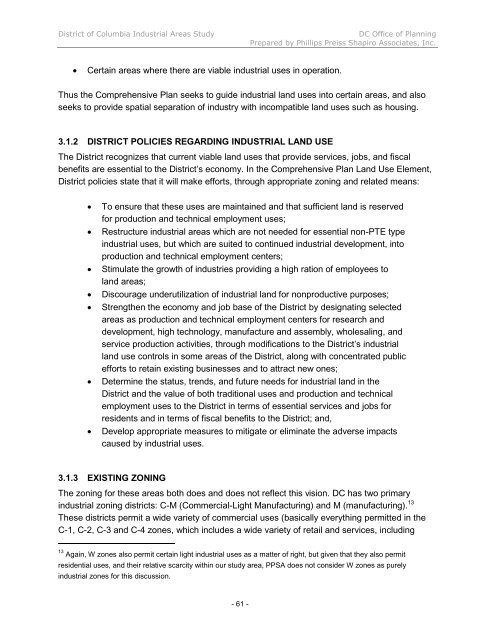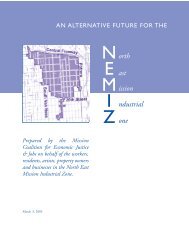INDUSTRIAL LAND IN A POST-INDUSTRIAL CITY District of ...
INDUSTRIAL LAND IN A POST-INDUSTRIAL CITY District of ...
INDUSTRIAL LAND IN A POST-INDUSTRIAL CITY District of ...
You also want an ePaper? Increase the reach of your titles
YUMPU automatically turns print PDFs into web optimized ePapers that Google loves.
<strong>District</strong> <strong>of</strong> Columbia Industrial Areas Study DC Office <strong>of</strong> Planning<br />
Prepared by Phillips Preiss Shapiro Associates, Inc.<br />
Certain areas where there are viable industrial uses in operation.<br />
Thus the Comprehensive Plan seeks to guide industrial land uses into certain areas, and also<br />
seeks to provide spatial separation <strong>of</strong> industry with incompatible land uses such as housing.<br />
3.1.2 DISTRICT POLICIES REGARD<strong>IN</strong>G <strong><strong>IN</strong>DUSTRIAL</strong> <strong>LAND</strong> USE<br />
The <strong>District</strong> recognizes that current viable land uses that provide services, jobs, and fiscal<br />
benefits are essential to the <strong>District</strong>’s economy. In the Comprehensive Plan Land Use Element,<br />
<strong>District</strong> policies state that it will make efforts, through appropriate zoning and related means:<br />
To ensure that these uses are maintained and that sufficient land is reserved<br />
for production and technical employment uses;<br />
Restructure industrial areas which are not needed for essential non-PTE type<br />
industrial uses, but which are suited to continued industrial development, into<br />
production and technical employment centers;<br />
Stimulate the growth <strong>of</strong> industries providing a high ration <strong>of</strong> employees to<br />
land areas;<br />
Discourage underutilization <strong>of</strong> industrial land for nonproductive purposes;<br />
Strengthen the economy and job base <strong>of</strong> the <strong>District</strong> by designating selected<br />
areas as production and technical employment centers for research and<br />
development, high technology, manufacture and assembly, wholesaling, and<br />
service production activities, through modifications to the <strong>District</strong>’s industrial<br />
land use controls in some areas <strong>of</strong> the <strong>District</strong>, along with concentrated public<br />
efforts to retain existing businesses and to attract new ones;<br />
Determine the status, trends, and future needs for industrial land in the<br />
<strong>District</strong> and the value <strong>of</strong> both traditional uses and production and technical<br />
employment uses to the <strong>District</strong> in terms <strong>of</strong> essential services and jobs for<br />
residents and in terms <strong>of</strong> fiscal benefits to the <strong>District</strong>; and,<br />
Develop appropriate measures to mitigate or eliminate the adverse impacts<br />
caused by industrial uses.<br />
3.1.3 EXIST<strong>IN</strong>G ZON<strong>IN</strong>G<br />
The zoning for these areas both does and does not reflect this vision. DC has two primary<br />
industrial zoning districts: C-M (Commercial-Light Manufacturing) and M (manufacturing). 13<br />
These districts permit a wide variety <strong>of</strong> commercial uses (basically everything permitted in the<br />
C-1, C-2, C-3 and C-4 zones, which includes a wide variety <strong>of</strong> retail and services, including<br />
13 Again, W zones also permit certain light industrial uses as a matter <strong>of</strong> right, but given that they also permit<br />
residential uses, and their relative scarcity within our study area, PPSA does not consider W zones as purely<br />
industrial zones for this discussion.<br />
- 61 -












